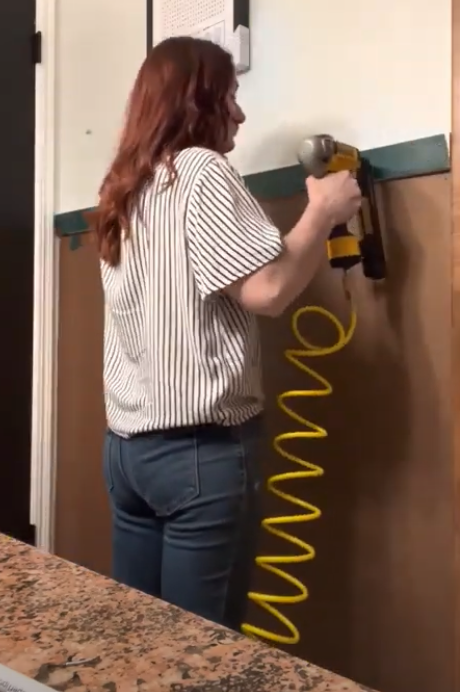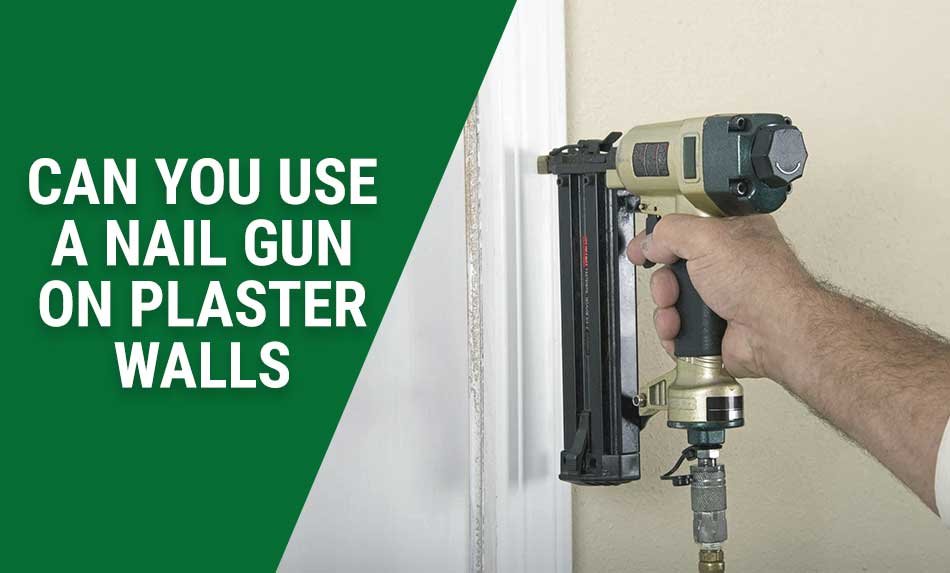Have you ever wondered if you can use a nail gun on plaster? Well, I’ve got the answer for you!
Picture this: you’re in the midst of a home improvement project, and you’re itching to hang some artwork or shelves on your plaster walls. But you’re not sure if a nail gun is the right tool to use.
In this article, we’ll dive into the question, “Can you nail gun into plaster?” and explore everything you need to know about using a nail gun on plaster walls. So, let’s get started and find out if you can use a nail gun to tackle your plaster hanging projects!
Using a nail gun on plaster can be a time-saving alternative to hand nailing. Follow these steps for a successful application:
- Prepare the area by removing any loose plaster.
- Find the studs behind the plaster using a stud finder.
- Choose the appropriate nail size and load them into the nail gun.
- Hold the nail gun firmly against the plaster and pull the trigger to drive the nail in.
- Repeat the process until all nails are in place.
Happy nailing!

Can You Nail Gun into Plaster?
When it comes to home improvement projects or DIY repairs, knowing what type of wall you’re working with is crucial. One common question that often arises is whether you can use a nail gun to attach items to plaster walls. In this article, we’ll explore the topic in depth, discussing the compatibility of nail guns with plaster, considerations to keep in mind, and alternative methods for mounting items on plaster walls.
The Compatibility of Nail Guns and Plaster: What You Need to Know
Plaster walls have been a popular choice for interior surfaces for centuries. However, they can pose some challenges when it comes to using a nail gun. Plaster is a brittle material that can easily crack or break under the force of a nail gun. Additionally, it’s important to note that older plaster walls may have a lath and plaster construction, which consists of wooden strips (lath) covered with multiple layers of plaster. This construction can make it even more difficult to use a nail gun effectively.
While it is technically possible to use a nail gun on plaster, it requires some extra precautions. Here are a few factors to consider before proceeding:
- Thickness of the plaster: Thicker plaster walls are generally more stable and less likely to crack. Before using a nail gun, make sure the plaster is at least 3/8 inch thick.
- Type of nail gun: Some nail guns are designed specifically for use with plaster. They feature adjustable depth settings that allow you to control the depth of the nail, minimizing the risk of damage to the plaster.
- Nail selection: Choose the right type of nails for plaster walls. Ring-shank nails or adhesive-coated nails provide better grip and reduce the chance of the nail loosening over time.
- Positioning: Avoid nailing close to the edges of the plaster, as this can increase the likelihood of cracking. Aim for the center of the wall or locate the wooden laths if present.
Keep in mind that even with these precautions, there is still a risk of damaging the plaster. It is essential to proceed with caution and consider alternative methods for mounting items on plaster walls.
Alternative Methods for Mounting Items on Plaster Walls
If you’re hesitant about using a nail gun on your plaster walls or want to explore other options, there are alternative methods you can consider. These methods provide a more secure and less risky way to attach items to plaster walls:
1. Adhesive Hooks and Strips
Adhesive hooks and strips are a popular choice for hanging lightweight items. They are easy to install and remove, leaving no damage to the plaster. However, keep in mind that adhesive hooks have weight limits, so make sure to choose the appropriate size and type for your needs.
When using adhesive hooks, make sure the surface of the plaster is clean and dry for better adhesion. Follow the instructions provided by the manufacturer for optimal results.
2. Picture Hanging Systems
A picture hanging system is a versatile option for hanging artwork and frames on plaster walls. This system typically consists of a track mounted on the wall and adjustable hooks that allow you to easily display and rearrange your pictures.
Picture hanging systems are designed to distribute the weight evenly along the wall, reducing the risk of damage. They are a more professional and long-term solution compared to adhesive hooks but may require some installation work.
3. Toggle Bolts
If you need to mount heavier items on plaster walls, toggle bolts can provide a secure hold. These bolts consist of a threaded end and a pair of spring-loaded wings. When inserted into the wall, the wings spring open, providing stability and support.
Using toggle bolts requires drilling holes into the plaster, so it’s crucial to follow the manufacturer’s instructions for proper installation. Be mindful of the weight limits specified for each toggle bolt size and choose the appropriate one for your project.
4. Picture Rail Molding
If you want a decorative and functional solution for hanging pictures and artwork, consider installing picture rail molding. Picture rail molding is a horizontal molding installed near the top of the wall, allowing you to hang frames using hooks and wires.
This method avoids the need to penetrate the plaster and provides flexibility in arranging and changing displays. Picture rail molding adds a touch of elegance to your walls and is commonly found in older homes with plaster walls.
Conclusion
While it is possible to use a nail gun on plaster walls, it requires caution and may not be the most suitable option. Considering the risk of damage to the plaster, alternative methods such as adhesive hooks, picture hanging systems, toggle bolts, and picture rail molding offer more secure and reliable ways to mount items on plaster walls. By choosing the right method for your needs and following proper installation guidelines, you can protect your plaster walls while still achieving your desired aesthetic and functionality.
Key Takeaways: Can You Nail Gun into Plaster?
- Yes, you can use a nail gun on plaster, but it requires some precautions.
- Make sure to use a nail gun specifically designed for plaster walls.
- Use shorter nails to prevent damaging the plaster layer.
- Test the nail gun on a small area of the wall to ensure it doesn’t crack or chip the plaster.
- Always wear safety goggles and ear protection when operating a nail gun.
Frequently Asked Questions
In this section, we will address some commonly asked questions about using a nail gun on plaster walls.
1. Can you use a nail gun on plaster walls?
Yes, you can use a nail gun on plaster walls, but it requires caution and certain considerations. First, you need to make sure your nail gun is suitable for plaster walls. Some nail guns are specifically designed for this purpose and have adjustable settings to prevent damage to the plaster. Second, it’s important to use the correct type and length of nails. Finishing nails or brad nails are recommended for plaster walls. Additionally, make sure the nails are not too long to avoid penetrating through the plaster and damaging hidden wiring or piping. Lastly, be mindful of the air pressure settings on your nail gun to prevent excessive force that could crack or break the plaster.
2. How do you prevent cracking or damaging plaster when using a nail gun?
To prevent cracking or damaging plaster when using a nail gun, follow these steps: First, locate the wall studs using a stud finder. Plaster walls are typically thicker than drywall, so it’s essential to anchor the nails into the studs for secure support. Mark the stud locations so you can aim your nails accurately. Next, set the air pressure on the nail gun to a lower setting to avoid excessive force that could cause damage. It’s also crucial to use nails that are the appropriate length for the job; they should be long enough to secure the item but not too long to penetrate through the plaster. Finally, position the nail gun at a slight angle and apply steady pressure when driving the nails into the plaster to minimize the risk of cracking.
3. Are there any alternative methods to using a nail gun on plaster walls?
Yes, there are alternative methods to using a nail gun on plaster walls. If you’re concerned about potential damage or prefer not to use a nail gun, you can opt for alternative hardware solutions. One option is using adhesive hooks or strips that are designed specifically for plaster walls. These hooks provide a secure hold and can be easily removed without causing damage. Another alternative is using wall anchors or toggle bolts, which provide sturdy support for heavier items. These alternatives allow you to hang items on plaster walls without the need for nails or a nail gun.
4. How do you repair plaster walls after using a nail gun?
If you accidentally damage the plaster while using a nail gun, there are steps you can take to repair it. Begin by removing any loose or damaged plaster around the nail hole. Use a utility knife or a chisel to gently chip away the damaged area until you reach a stable surface. Then, clean the area around the hole with a brush and damp cloth to remove any debris. Apply a thin layer of joint compound or plaster patching compound to the hole, smoothing it out with a putty knife. Allow it to dry completely, and then sand it lightly to blend it with the surrounding surface. Finally, prime and paint the patched area to match the rest of the wall. If the damage is extensive or beyond your repair capabilities, it may be best to consult a professional plasterer.
5. Can you use a nail gun on other types of plaster, such as lath and plaster walls?
While it is possible to use a nail gun on lath and plaster walls, it requires special care. Lath and plaster walls are constructed differently from solid plaster walls, with wooden laths used as a base for the plaster. When using a nail gun on lath and plaster walls, it’s crucial to aim for the wooden laths to ensure secure fastening. You can use a stud finder to locate the laths behind the plaster surface. It’s also important to use the appropriate length and type of nails, ensuring they penetrate the plaster and securely anchor into the laths. As always, it’s recommended to use a lower air pressure setting on the nail gun to prevent damage to the plaster. If you’re uncertain or have extensive work to be done, consulting a professional is advisable to ensure the best results.

Summary
Plaster is a delicate material, and using a nail gun on it can cause damage. It’s best to use alternative methods like screws or adhesive hooks to hang things on plaster walls. If you must use a nail gun, be cautious and use low pressure to minimize the risk of cracking the plaster.
While it may seem convenient, nail guns should be used with caution when working with plaster. The force from a nail gun can easily crack or break the delicate surface of plaster walls. It’s safer to opt for other methods that are less likely to cause damage, such as screws or adhesive hooks. If you do decide to use a nail gun, make sure to use low pressure to reduce the risk of harming the plaster.
